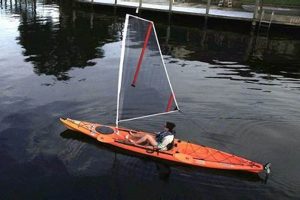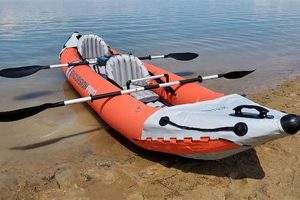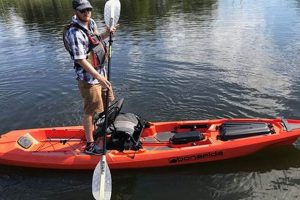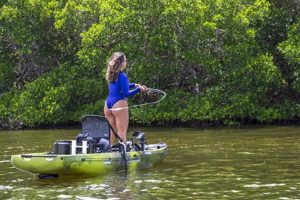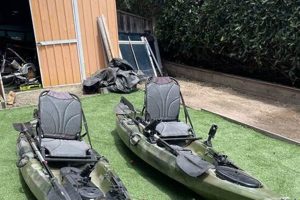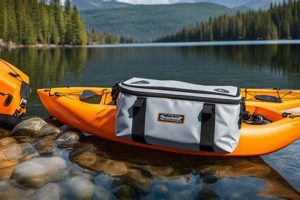A kayak designed for fishing, approximately 3 meters in length, offers anglers a compact and maneuverable vessel for navigating smaller bodies of water and accessing hard-to-reach fishing spots. This size strikes a balance between stability and portability, making it suitable for transportation on car roof racks or smaller trailers.
Compact fishing kayaks provide an affordable and accessible entry point into kayak fishing. Their shorter length allows for enhanced maneuverability in tight spaces like creeks and rivers, while still offering sufficient stability for casting and reeling. This size category has grown in popularity due to increasing interest in fishing combined with the need for easily transportable watercraft.
The following sections delve deeper into specific topics related to selecting, outfitting, and utilizing a compact fishing kayak, including stability considerations, propulsion options, and essential gear for a successful fishing excursion.
Tips for Compact Kayak Fishing
Effective angling from a smaller kayak requires careful planning and execution. The following tips offer guidance for maximizing success and enjoyment on the water.
Tip 1: Prioritize Stability: A stable platform is paramount for casting and landing fish. Consider kayaks with wider beams and flatter hulls for enhanced stability. Test stability before purchase if possible.
Tip 2: Choose Appropriate Propulsion: Paddle propulsion offers excellent exercise and control in calm waters. Pedal-powered kayaks allow hands-free fishing and faster travel, especially over longer distances.
Tip 3: Plan Gear Placement Strategically: Limited space necessitates careful organization. Utilize rod holders, tackle boxes, and storage compartments to keep essential gear within easy reach and prevent clutter.
Tip 4: Pack Light and Efficiently: Bring only necessary equipment to avoid overloading the kayak and compromising stability. Waterproof bags and containers are essential for protecting electronics and other sensitive items.
Tip 5: Practice Safety First: Always wear a personal flotation device (PFD). Inform someone of your fishing location and estimated return time. Carry a whistle or other signaling device for emergencies. Check weather conditions before embarking.
Tip 6: Respect the Environment: Practice catch-and-release whenever possible. Properly dispose of all trash and fishing line. Adhere to local fishing regulations and respect wildlife.
Tip 7: Master Kayak Control: Practice paddling and maneuvering in calm water before venturing into more challenging conditions. Understand how wind and currents affect kayak handling.
By adhering to these guidelines, anglers can enhance their safety, efficiency, and overall enjoyment while fishing from a compact kayak, ultimately leading to a more rewarding experience on the water.
The following section offers concluding thoughts on the versatility and practicality of compact fishing kayaks in today’s angling landscape.
1. Maneuverability
Maneuverability represents a critical performance attribute in a 10-foot fishing kayak, directly influencing its suitability for specific fishing environments. A kayak’s ability to navigate tight turns, weave through obstacles, and respond efficiently to paddle input dictates access to prime fishing locations often inaccessible to larger vessels. This agility proves particularly advantageous in smaller rivers, creeks, and vegetated shorelines where precise boat control is essential for presenting lures and fighting fish effectively.
The shorter length of a 10-foot kayak contributes significantly to its enhanced maneuverability. A shorter hull requires less effort to initiate turns and allows for quicker changes in direction compared to longer kayaks. This responsiveness allows anglers to exploit narrow channels, navigate around fallen trees or rocks, and position the kayak precisely for optimal casting angles. For example, accessing secluded pockets of water beneath overhanging branches, where fish often congregate, becomes achievable with a highly maneuverable kayak. This advantage translates to increased fishing opportunities and potentially higher catch rates.
Understanding the connection between kayak length and maneuverability is crucial for anglers selecting a vessel suited to their target fishing environment. While shorter kayaks excel in confined spaces, they may sacrifice some tracking performance in open water compared to longer designs. Therefore, anglers should carefully consider the balance between maneuverability and tracking based on the predominant type of water they intend to fish. Prioritizing maneuverability in a 10-foot kayak opens access to productive fishing grounds often unreachable by other means, significantly enhancing the angling experience.
2. Portability
Portability stands as a defining characteristic of the 10-foot journey fishing kayak, significantly impacting its accessibility and overall user experience. The ease with which a kayak can be transported and handled directly influences its appeal, particularly for anglers lacking specialized trailers or ample storage space. Understanding the factors contributing to portability is essential for selecting a kayak that aligns with individual logistical needs and preferences.
- Weight and Dimensions:
A 10-foot kayak’s compact size and relatively low weight, typically ranging between 40 and 70 pounds depending on construction and features, render it manageable for transport. This size allows for car-topping on roof racks or loading into truck beds without requiring dedicated trailers. The manageable weight allows for single-person handling in many cases, simplifying launch and retrieval processes. For example, an angler can easily load and unload a lightweight kayak from a vehicle roof rack without assistance, enhancing convenience and reducing reliance on others.
- Hull Design and Materials:
Hull material significantly impacts overall weight. Kayaks constructed from rotomolded polyethylene offer durability and affordability, while lighter-weight composites like fiberglass or carbon fiber provide weight savings at a premium. The choice of material involves a trade-off between durability, cost, and portability. A rotomolded kayak, while heavier, might withstand impacts and abrasion better than a lighter composite model, making it suitable for rugged environments. Conversely, a composite kayak excels in portability, reducing strain during transport and handling.
- Transportation Infrastructure:
The availability of suitable transportation infrastructure plays a role in portability. Access to appropriate roof racks, tie-down straps, and loading aids facilitates transport. Anglers should ensure compatibility between their vehicle and the chosen kayak’s dimensions and weight capacity before purchase. For example, a compact car with a lightweight roof rack may not be suitable for carrying a heavier rotomolded kayak, highlighting the need to assess vehicle capabilities alongside kayak specifications.
- Storage Considerations:
Storage space availability influences kayak choice. A 10-foot kayak’s compact size often allows for storage in garages, sheds, or even apartments, eliminating the need for dedicated outdoor storage areas. This ease of storage enhances accessibility, allowing for spontaneous fishing trips without the logistical hurdles of retrieving a kayak from remote storage locations. For example, an angler can easily store a 10-foot kayak inside a garage, allowing for quick access and preparation for fishing excursions.
The portability of a 10-foot journey fishing kayak expands its appeal to a broader audience, eliminating logistical barriers associated with larger, heavier vessels. The interplay of weight, dimensions, materials, and transportation infrastructure dictates the overall portability of a kayak, and aligning these factors with individual needs and circumstances ensures a seamless and enjoyable fishing experience. Choosing a highly portable kayak reduces transport and storage burdens, ultimately increasing time spent on the water.
3. Stability
Stability forms a cornerstone of effective kayak fishing, particularly in smaller vessels like the 10-foot journey fishing kayak. A stable platform enables anglers to cast, retrieve, and land fish efficiently, while also ensuring safety and comfort throughout the fishing experience. Several factors influence stability in a kayak, including hull design, width, and weight distribution. Understanding the interplay of these elements empowers informed decision-making when selecting a kayak for fishing purposes.
Hull design plays a pivotal role in determining stability. Wider, flatter hulls generally offer greater initial stability, resisting tipping during common fishing movements like casting or reeling. This design prioritizes stability over speed and maneuverability, making it well-suited to calmer waters where precise boat control is less critical. Conversely, narrower, V-shaped hulls enhance tracking and speed but compromise initial stability. Anglers prioritizing stability often favor wider hulls, accepting potential trade-offs in other performance characteristics. For instance, a wider hull provides a more secure platform for standing while casting in calm conditions, a significant advantage for sight fishing. However, this same hull may feel sluggish and less responsive in windy or choppy conditions. The angler’s intended fishing environment and preferred techniques inform the optimal hull design for maximizing stability.
Weight distribution also significantly impacts stability. Keeping weight low and centered within the kayak enhances stability, reducing the likelihood of capsizing. Proper placement of gear and even weight distribution between anglers, if applicable, contribute to a more stable platform. Overloading a kayak or concentrating weight at either end compromises stability and increases the risk of tipping. For example, unevenly distributing fishing gear towards the stern can cause the bow to rise, increasing susceptibility to wind and waves. Careful attention to weight distribution, both during loading and while on the water, is essential for maintaining a stable and safe fishing platform. Understanding these principles allows anglers to optimize stability and enhance their fishing experience in a 10-foot journey fishing kayak.
4. Storage Capacity
Storage capacity represents a critical consideration for anglers evaluating 10-foot journey fishing kayaks. Effective organization and accessibility of essential gear directly impact fishing efficiency and overall enjoyment on the water. Limited space necessitates careful planning and utilization of available storage options. Understanding various storage features and their implications allows for informed decisions aligned with individual fishing styles and equipment needs.
- Built-In Storage Compartments:
Many 10-foot fishing kayaks feature integrated storage compartments, including hatches, tank wells, and dry storage areas. These compartments offer designated spaces for tackle boxes, safety gear, and personal items, protecting them from water and ensuring organized storage. Rear tank wells, for example, accommodate larger items like crates or tackle bags, while smaller hatches located near the angler’s seat provide quick access to frequently used items like lures or tools. The size, location, and accessibility of these compartments influence their practicality for specific gear and fishing styles.
- Rod Holders and Management Systems:
Dedicated rod holders, whether flush-mounted or adjustable, are essential for securing fishing rods during transport and while fishing. These holders prevent rod entanglement and damage while freeing the angler’s hands for paddling or other tasks. Some kayaks incorporate advanced rod management systems that allow for adjustable positioning and easy access to multiple rods. The number, type, and placement of rod holders impact fishing versatility and efficiency. For example, multiple flush-mounted rod holders allow for trolling various lines simultaneously, while adjustable holders cater to different fishing techniques and rod lengths.
- Bungee Cord Systems and Deck Rigging:
Bungee cord systems and deck rigging offer versatile storage solutions for items requiring quick access, such as paddles, dry bags, or extra layers of clothing. These systems secure items on the kayak’s deck, keeping them within reach while maximizing space within the hull. Strategic placement of bungee cords and deck rigging enhances organization and streamlines gear retrieval during critical moments. For instance, securing a paddle float to the deck using bungee cords ensures immediate access in the event of a capsize, while a strategically placed dry bag keeps essential electronics safe and accessible.
- Aftermarket Storage Accessories:
A variety of aftermarket accessories, including tackle bags, crates, and mounting systems, further expand storage options for 10-foot kayaks. These accessories cater to specific needs and preferences, allowing anglers to customize their storage solutions for maximum efficiency. For example, a waterproof tackle bag attached to the deck rigging provides organized storage for lures and terminal tackle, while a crate secured in the tank well offers ample space for larger items. Carefully selecting and integrating aftermarket accessories maximizes storage capacity while maintaining balance and stability.
Optimizing storage capacity in a 10-foot journey fishing kayak is crucial for a successful and enjoyable fishing experience. By carefully considering built-in compartments, rod management systems, deck rigging, and aftermarket accessories, anglers can create an organized and efficient storage system tailored to their specific needs. Maximizing storage space enhances on-the-water efficiency and contributes to a more streamlined and rewarding fishing experience. Thoughtful storage planning allows anglers to focus on the task at hand catching fish.
5. Fishing Features
Specialized features distinguish fishing kayaks from recreational models, enhancing angling efficiency and overall experience. These features, tailored to the demands of fishing, play a crucial role in the functionality of a 10-foot journey fishing kayak, directly influencing its effectiveness on the water. The following facets explore key fishing features commonly found in these compact vessels.
- Rod Holders
Rod holders provide secure storage and easy access to fishing rods. Multiple rod holders, strategically positioned, allow anglers to troll several lines simultaneously or switch between different rod and reel setups efficiently. Adjustable rod holders accommodate various rod lengths and fishing styles. For example, a kayak equipped with flush-mounted rod holders along the gunwales permits trolling while paddling, while adjustable rod holders near the seat offer quick access to frequently used rods. The presence and configuration of rod holders significantly impact an angler’s ability to manage multiple lines and adapt to changing fishing conditions.
- Tackle Storage
Dedicated tackle storage solutions are essential for maintaining organization and readily accessing lures, hooks, and other fishing essentials. Integrated tackle boxes, compartments, and storage trays keep gear secure and protected from the elements. Easy-access storage compartments within reach of the angler’s seat streamline lure changes and minimize disruptions during fishing. For instance, a built-in tackle box located beneath the seat allows for quick retrieval of lures without requiring the angler to reach into a larger storage compartment. Efficient tackle storage contributes directly to fishing efficiency and reduces time spent searching for gear.
- Paddle/Pedal Propulsion Options
Propulsion systems significantly influence fishing range and accessibility. Paddle propulsion offers maneuverability and affordability, suitable for navigating tight spaces and exploring shallow waters. Pedal-powered kayaks provide hands-free fishing and increased speed over longer distances, enabling anglers to cover more water and reach distant fishing spots. The choice of propulsion depends on individual fishing preferences, target environments, and physical capabilities. For example, a pedal-drive system allows for hands-free trolling or jigging, while paddle propulsion offers greater maneuverability in shallow, obstacle-filled waterways. Selecting the appropriate propulsion system enhances fishing versatility and expands access to productive fishing areas.
- Anchor System
Anchor systems allow anglers to maintain position in desired locations, particularly in current or wind. Integrated anchor trolleys and deck-mounted anchor cleats facilitate controlled deployment and retrieval of anchors, minimizing disruptions to the fishing process. A well-designed anchor system keeps the kayak securely positioned, allowing anglers to focus on fishing rather than constantly adjusting position. For instance, an anchor trolley system allows for precise anchor placement, enabling anglers to position the kayak optimally in relation to structure or current breaks. Effective anchor deployment enhances fishing precision and improves catch rates by keeping the angler in the ideal fishing zone.
These fishing-specific features transform a standard kayak into a dedicated fishing platform, enhancing angling effectiveness and enjoyment. By carefully considering the presence, placement, and functionality of these features, anglers can select a 10-foot journey fishing kayak that aligns precisely with their individual fishing style, target species, and preferred fishing environment. The integration of these features contributes significantly to the overall functionality and value of a compact fishing kayak, ultimately maximizing its potential on the water.
6. Hull Design
Hull design significantly influences the performance characteristics of a 10-foot journey fishing kayak, impacting stability, maneuverability, tracking, and speed. Understanding the nuances of various hull designs empowers informed decision-making, aligning kayak selection with specific fishing environments and angler preferences. The following facets explore key hull design variations and their implications for compact fishing kayaks.
- Flat Bottom Hull
Flat bottom hulls provide exceptional initial stability, making them ideal for calm water fishing where standing or frequent shifting of weight is anticipated. This stability comes at the expense of tracking and speed, making them less suitable for paddling longer distances or in windy conditions. A flat bottom hull excels in protected bays, ponds, and slow-moving rivers where maintaining position and stability while casting or landing fish is paramount. However, this design may feel sluggish and unresponsive in open water or when paddling against currents. For example, anglers fishing for panfish in shallow, calm ponds benefit greatly from the stability offered by a flat bottom hull, while those targeting pelagic species in open lakes might find its lack of speed and tracking a hindrance.
- Rounded Hull
Rounded hulls offer a balance between stability and maneuverability. They provide moderate initial stability while also allowing for efficient turning and responsiveness to paddle input. This design proves versatile in various fishing environments, from calm lakes to slow-moving rivers. While not as stable as flat bottom hulls, rounded hulls offer improved tracking and glide compared to their flatter counterparts. For instance, a rounded hull performs well in sheltered coastal areas where moderate chop and currents are present, allowing anglers to navigate effectively while maintaining reasonable stability. This design represents a compromise between stability and maneuverability, suiting anglers who value both attributes.
- V-Shaped Hull
V-shaped hulls prioritize speed and tracking, making them well-suited for open water and covering longer distances efficiently. They slice through waves and currents effectively, minimizing resistance and maximizing glide. However, V-shaped hulls sacrifice initial stability compared to flatter designs, requiring more experience and balance from the angler. For example, anglers targeting offshore species or paddling across larger lakes benefit from the speed and tracking of a V-shaped hull, while those fishing in shallow, protected areas might find its reduced stability challenging. This design caters to anglers prioritizing speed and efficiency over maximum initial stability.
- Pontoon Hull
Pontoon hulls provide exceptional stability, surpassing even flat bottom designs. The added buoyancy of pontoons creates a highly stable platform ideal for standing and fishing in calm conditions. However, pontoon hulls sacrifice maneuverability and speed due to increased drag and resistance. They excel in sheltered environments where stability is paramount, such as shallow flats or protected bays. For example, anglers sight-fishing in shallow, calm waters benefit greatly from the unparalleled stability of a pontoon hull, while those navigating tight, winding creeks might find its limited maneuverability restrictive. This design caters to anglers prioritizing maximum stability above other performance characteristics.
Careful consideration of hull design ensures the selection of a 10-foot journey fishing kayak optimized for the intended fishing environment and angler preferences. Each hull design presents unique performance characteristics, with trade-offs between stability, maneuverability, speed, and tracking. Aligning hull design with specific fishing needs maximizes efficiency and enjoyment on the water. The ideal hull design depends on the specific balance of performance characteristics prioritized by the angler, influencing their ability to navigate, position, and fish effectively in their chosen environment.
7. Weight Capacity
Weight capacity represents a critical factor influencing the safety and performance of a 10-foot journey fishing kayak. This specification dictates the maximum combined weight of the angler, gear, and any additional cargo the kayak can safely support. Understanding weight capacity and its implications is essential for preventing overloading, ensuring stability, and maximizing the kayak’s performance on the water.
- Safety Implications
Exceeding the specified weight capacity compromises stability and increases the risk of capsizing. A kayak operating near its maximum capacity sits lower in the water, reducing freeboard and increasing susceptibility to swamping in waves or rough conditions. Maintaining a safe margin below the maximum weight capacity ensures adequate freeboard and enhances overall stability, crucial for safe navigation and angler security. For example, attempting to carry excessive gear or exceeding the recommended weight limit can lead to instability, particularly in challenging conditions, increasing the risk of capsizing or taking on water. Prioritizing safety requires careful consideration of weight capacity and adherence to manufacturer recommendations.
- Performance Impact
Weight influences a kayak’s performance characteristics, including speed, maneuverability, and tracking. An overloaded kayak sits lower in the water, creating increased drag and reducing paddling efficiency. This added weight requires greater effort to propel the kayak and diminishes responsiveness to paddle input. Maintaining a reasonable weight below the maximum capacity ensures optimal performance and efficient paddling. For example, a heavily loaded kayak may struggle to maintain speed and maneuver effectively in currents or wind, hindering the angler’s ability to reach desired fishing locations or navigate challenging conditions. Optimizing performance necessitates careful management of weight and adherence to recommended capacity limits.
- Gear Considerations
Weight capacity dictates the amount of gear an angler can safely carry. Fishing gear, including rods, reels, tackle boxes, and safety equipment, contributes significantly to overall weight. Anglers must carefully consider the combined weight of their essential gear and personal items when selecting a kayak with appropriate weight capacity. Packing light and prioritizing essential gear maximizes available capacity and ensures safe operation within the kayak’s specified limits. For example, opting for lighter-weight tackle boxes or minimizing non-essential gear can significantly reduce overall weight, allowing for greater flexibility in carrying essential fishing equipment and personal items without exceeding the kayak’s capacity. Careful gear selection contributes to efficient packing and optimal weight management.
- Individual Angler Weight
Angler weight represents a substantial portion of the total weight carried by the kayak. Individuals should accurately assess their weight, including clothing and any personal items, when determining the suitability of a kayak’s weight capacity. Selecting a kayak with ample capacity ensures safe and comfortable operation without compromising performance or stability. For example, an angler weighing 200 pounds requires a kayak with significantly greater weight capacity than an angler weighing 150 pounds, assuming similar gear loads. Accurately assessing individual weight is crucial for selecting a kayak capable of safely supporting the angler and their essential gear. Failing to consider angler weight can lead to overloading and compromise both safety and performance.
Understanding weight capacity is paramount for safe and efficient operation of a 10-foot journey fishing kayak. Careful consideration of angler weight, gear requirements, and performance implications ensures optimal kayak selection and enhances the overall fishing experience. Adhering to manufacturer-specified weight limits prioritizes safety and maximizes the kayak’s performance potential on the water. Responsible weight management contributes significantly to a safe, enjoyable, and productive fishing experience.
Frequently Asked Questions
This section addresses common inquiries regarding 10-foot journey fishing kayaks, providing concise and informative responses to assist in informed decision-making.
Question 1: What advantages do 10-foot kayaks offer for fishing?
Ten-foot kayaks offer a balance of maneuverability and portability ideal for smaller bodies of water and challenging access points. Their compact size simplifies transport and storage while maintaining sufficient stability for fishing activities.
Question 2: Are 10-foot kayaks suitable for ocean fishing?
While capable of handling calm coastal waters and protected bays, 10-foot kayaks are generally not recommended for open ocean or rough conditions due to their smaller size and limited stability compared to larger sea kayaks.
Question 3: How much weight can a typical 10-foot fishing kayak hold?
Weight capacity varies depending on the specific model and construction. However, most 10-foot fishing kayaks have a weight capacity ranging from 250 to 350 pounds, encompassing angler weight, gear, and additional cargo.
Question 4: What essential features should one look for in a 10-foot fishing kayak?
Essential features include rod holders, tackle storage compartments, comfortable seating, and a stable hull design. Additional features like anchor systems, rudders, and paddle/pedal propulsion options enhance fishing versatility and efficiency.
Question 5: What are the primary differences between sit-on-top and sit-inside 10-foot fishing kayaks?
Sit-on-top kayaks offer enhanced stability and easier entry/exit, making them suitable for warmer climates and anglers who prefer greater freedom of movement. Sit-inside kayaks provide better protection from the elements and offer drier seating, making them suitable for colder conditions or longer paddling trips.
Question 6: How does one choose between paddle and pedal propulsion for a 10-foot fishing kayak?
Paddle propulsion offers affordability, simplicity, and maneuverability in tight spaces. Pedal propulsion provides hands-free fishing and increased speed, particularly beneficial for covering longer distances or fishing in currents. The choice depends on individual fishing styles, target environments, and physical capabilities.
Careful consideration of these frequently asked questions assists prospective buyers in navigating the selection process and choosing a 10-foot journey fishing kayak best suited to their individual needs and fishing preferences.
The following section explores advanced techniques for maximizing fishing success from a 10-foot kayak platform.
Conclusion
Exploration of the 10-foot journey fishing kayak reveals a specialized vessel designed for anglers seeking maneuverability, portability, and accessibility in diverse aquatic environments. Key attributes impacting performance include hull design, stability considerations, storage capacity, specialized fishing features, and weight capacity limitations. Careful evaluation of these interconnected factors empowers informed decision-making, aligning kayak selection with individual angler requirements and fishing styles.
The 10-foot journey fishing kayak represents a versatile platform enabling anglers to explore previously inaccessible fishing grounds, maximizing angling opportunities while minimizing logistical constraints. Continued innovation in kayak design and technology promises further enhancements to this popular fishing platform, expanding its capabilities and solidifying its role in the evolving landscape of modern angling.

